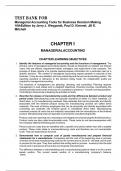Exam (elaborations)
Test Bank for Financial Accounting Tools For Business Decision Making 10th Edition Paul D. Kimmel, Jerry J. Weygandt, Jill E. Mitchell ||Complete A+ Guide
Test Bank for Financial Accounting Tools For Business Decision Making 10th Edition Paul D. Kimmel, Jerry J. Weygandt, Jill E. Mitchell ||Complete A+ Guide
[Show more]



